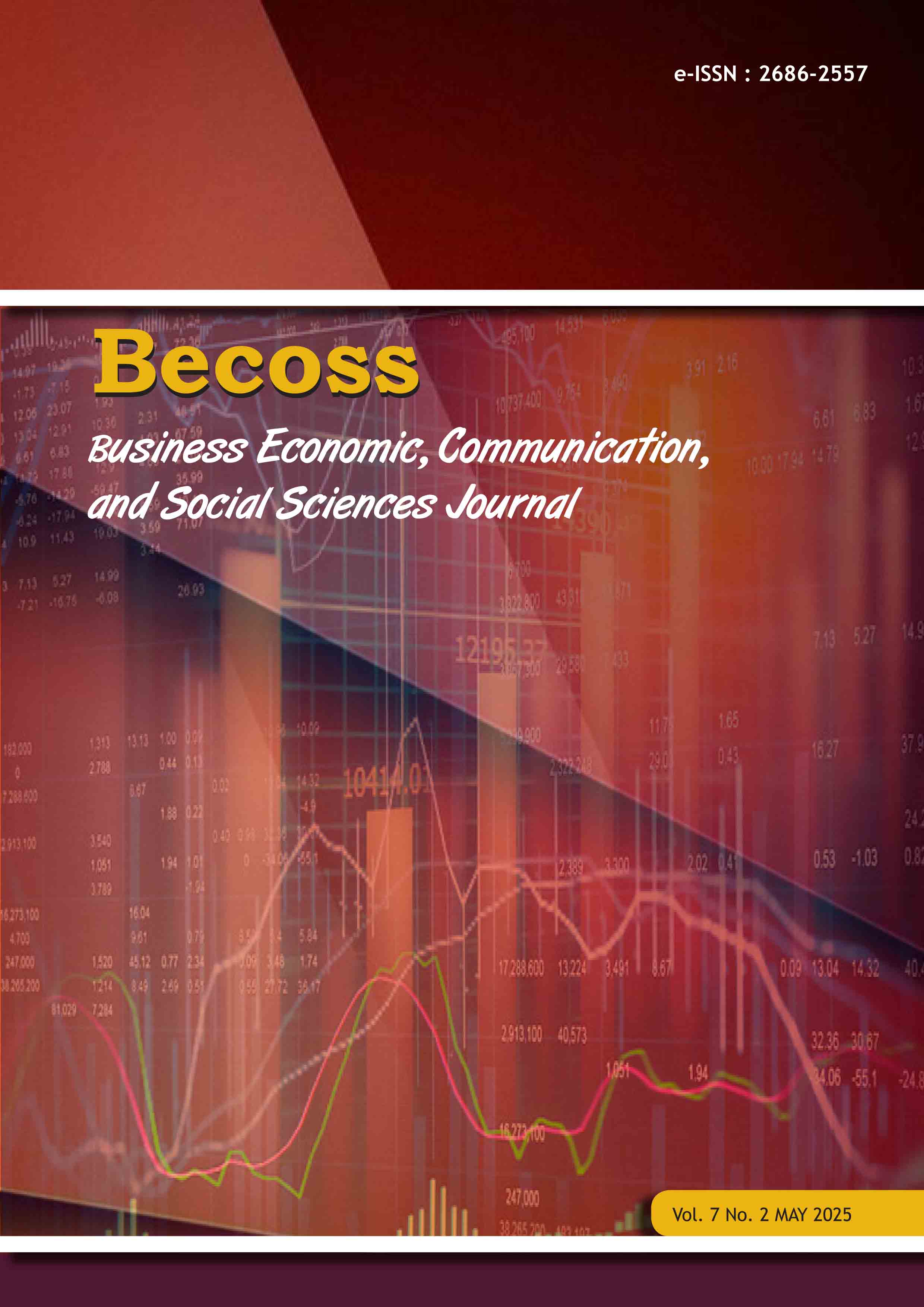Assessing the Impacts of Exports, Gross Capital Formation, Imports, Gross National Income, and Inflations on New Zealand’s Growth Trajectory
DOI:
https://doi.org/10.21512/becossjournal.v7i2.13054Keywords:
Economic Growth, Macroeconomic Indicators, Regression Analysis, New ZealandAbstract
This research investigates the impact of gross national income (GNI), gross capital formation (GCF), exports of goods and services (EXP), imports of goods and services (IMP), and inflation and consumer prices (INF) on economic growth (GDP) in New Zealand (NZ). The study employs various statistical tests such as; normality, serial correlation, heteroscedasticity, and multicollinearity to test whether the model fits the data and the test results show that the model is statistically feasible. The time series data were derived from the World Bank data indicators website in NZ using a purposive sampling technique for fifty-one (51) year period, from 1972 to 2022, and the data were analyzed through Eviews 10 software versions. The results of the regression analysis show that GNI, GCF, EXP, and IMP have positive and significant impacts on GDP, while INF has a negative and insignificant impact on GDP. The research contributes to the understanding of key indicators in enhancing economic growth in NZ. The findings of this research suggest that improving export, national savings, capital formation, importation of raw materials will contribute immensely to the economic growth of NZ. In addition, the research also suggests that inflation should be controlled, as it may hinder the country’s economic growth. Controlling inflation is essential to boosting income generation and economic productivity. However, future research should consider broader geographical contexts of different nations, increase sample size, and variables for a comprehensive understanding of factors influencing economic growth over time.
References
Abdulkadr, A. A., Asnakew, Y. W., Sendkie, F. B., Workineh, E. B., & Asfaw, D. M. (2024). Analyzing the dynamics of monetary policy and economic growth in Ethiopia: an autoregressive distributed lag (ARDL) approach. Discover Sustainability, 5(1). https://doi.org/10.1007/s43621-024-00271-w
Acikgoz, B., & Cinar, S. (2017). Public spending and economic growth: An empirical analysis of developed countries. Ekonomicky Casopis, 65(5), 448–458.
Ahmed, M., & Khalil, J. (2014). Impact of Foreign Direct Investment , Imports , Exports of Goods and Services on Economic Growth of Pakistan . Bulletin of Business and Economics. Bulletin of Business and Economics, 3(3), 155–165.
Akobeng, E. (2017). Gross Capital Formation, Institutions and Poverty in Sub-Saharan Africa. Journal of Economic Policy Reform, 20(2), 136–164. https://doi.org/10.1080/17487870.2015.1128833
Ali, M., Ali, M., & Porter, D. C. (2021). Multicollinearity Chapter 10 : Multicollinearity Written by : Damodar N . Gujarati. January. https://doi.org/10.13140/RG.2.2.20731.34088
Amjed, S., & Shah, I. A. (2021). Does financial system development, capital formation and economic growth induces trade diversification? Journal of Economics and Development, 23(3), 222–237. https://doi.org/10.1108/JED-06-2020-0073
Aziz, R. N. A. R., & Amalina, A. (2017). Factor Affecting Gross Domestic Product (Gdp) Growth in Malaysia. International Journal of Real Estate Studies, 11(4), 2017. http://www.utm.my/intrest/files/2017/09/07-FACTOR-AFFECTING-GROSS-DOMESTIC-PRODUCT-GDP-GROWTH-IN-MALAYSIA1.pdf
Balassa, B. (1985). World Bank Reprint Series: Number 372. Journal of Development Economics, 18(372), 23–35.
Barker, A. (2017). Improving productivity in New Zealand’s economy. 1419, 77–122. https://doi.org/10.1787/eco_surveys-nzl-2017-6-en
Beck, N., & Katz, J. N. (2011). Modeling dynamics in time-series-cross-section political economy data. Annual Review of Political Science, 14, 331–352. https://doi.org/10.1146/annurev-polisci-071510-103222
Bergh, J. C. J. M. va. den. (2009). The GDP paradox. Journal of Economic Psychology, 30(2), 117–135. https://doi.org/10.1016/j.joep.2008.12.001
Beroud, M. (2024). Essays on Global Value Chains and Agri-food Systems Transformation.
Black, S. (1998). an Econometric Analysis of New Zealand’S Determinants of Economic Growth 1960-1996.
Bureau, N., & Economic, O. F. (1994). Jong-Wha Lee The author is grateful to Robert Barro , Susan Collins and Elhanan Helpman for their helpful comments on earlier drafts of this paper . This paper is part of NBER ’ s research programs in Growth and International Trade and Investment . Any op. 4725.
Burks, J. J., Randolph, D. W., & Seida, J. A. (2019). Modeling and interpreting regressions with interactions. Journal of Accounting Literature, 42(August 2018), 61–79. https://doi.org/10.1016/j.acclit.2018.08.001
Capelli, C., & Vaggi, G. (2016). Why Gross National Disposable Income Should Replace Gross National Income. Development and Change, 47(2), 223–239. https://doi.org/10.1111/dech.12225
Carroll, N. (2012). Structural Change in the New Zealand Economy 1974-2012 Long-Term Fiscal External Panel. July, 1–32. http://www.treasury.govt.nz/government/longterm/externalpanel/pdfs/ltfep-s1-04.pdf
Conway, P., & Orr, A. (2000). Articles The process of economic growth in New Zealand. Reserve Bank of New Zealand Bulletin, 63(1), 4–20. http://www.rbnz.govt.nz/research_and_publications/articles/details.aspx?id=3671
Dalziel, P. (2016). Wellbeing Economics and Treasury ’ s Perspective on New Zealand ’ s Economic Performance. March.
David, B., & Emmanuel, F. (2021). No SUPPLY AND DEMAND IN DISAGGREGATED KEYNESIAN ECONOMIES WITH AN APPLICATION TO THE COVID-19 CRISIS. Pharmacognosy Magazine, 75(17), 399–405.
Dorfman, R. (2024). The Review of Economics and Statistics. Economic Theory and Public Decisions, 85(4), 44–56. https://doi.org/10.4337/9781035334919.00011
Dyché, J., Geiger, J. G., McGivern, M., McKnight, W., & Zeid, A. (2011). Business Intelligence Journal 2011. In Business Intelligence Journal (Vol. 16, Issue 1).
Fatai, K., Oxley, L., & Scrimgeour, F. G. (2020). Modeling and Forecasting the Demand for Electricity in New Zealand : A Comparison of Alternative Approaches Author ( s ): Koli Fatai , Les Oxley and Frank G . Scrimgeour Published by : International Association for Energy Economics Stable URL : https://ww. 24(1), 75–102.
Ferreira, P. C. (2009). Trade in Intermediate Goods and Total Factor Productivity. 93.
Florida, S., Florida, R., & Meilander, K. (2008). Inside the black box of regional development — human capital , the creative class and tolerance Inside the black box of regional development — human capital , the creative class and tolerance. 8(5), 615–649. https://doi.org/10.1093/jeg/lbn023
Fosu, A. K. (1990). Exports and economic growth: The African case. World Development, 18(6), 831–835. https://doi.org/10.1016/0305-750X(90)90005-I
Gabriele, A. (2006). Exports of Services, Exports of Goods, and Economic Growth in Developing Countries. Journal of Economic Integration, 21(2), 294–317. https://doi.org/10.11130/jei.2006.21.2.294
Galt, D. (2000). New Zealand ’ s Economic Growth. 00.
Geoffrey, T. F., Anthony, M., Alan, J., Brooke, S. C., Geoffrey, T. F., Anthony, M., & The, A. J. (2016). The Economists and New Zealand Population : Problems and Policies 1900 – 1980s School of Economics Working Paper Series The Economists and New Zealand Population : Problems and Policies 1900 – 1980s.
Gourieroux, C., Monfort, A., & Trognon, A. (1985). A general approach to serial correlation. Econometric Theory, 1(3), 315–340. https://doi.org/10.1017/S0266466600011245
Grossman, V., MacK, A., & Martinez-Garcia, E. (2014). A new database of global economic indicators. Journal of Economic and Social Measurement, 39(3), 163–197. https://doi.org/10.3233/JEM-140391
Hernandez, H. (2021). ForsChem Research Reports. ForsChem Research, 6, 1–38. https://doi.org/10.13140/RG.2.2.13926.14406
Hirschman, D. (2013). Review : KUZNETS ’ LOST LEGACY . REVIEW OF FOGEL " ET ALII , POLITICAL ARITHMETIC " Reviewed Work ( s ): Political Arithmetic : Simon Kuznets and the Empirical Tradition in Economics by Robert W . Fogel , Enid M . Fogel , Mark Guglielmo and Nathaniel Grot. 21(3), 127–133.
Islam, M. R., & Haque, M. (2018). The Success of Export and Its Impact to the GDP of Bangladesh. Journal of Social Sciences and Humanities, 1(1), 63–67. http://www.aascit.org/journal/archive2?journalId=931&paperId=6460
Jalal, S. (2020). SPAEF EFFECT OF GNI ON INFANT MORTALITY RATE IN LOW INCOME , LOWER MIDDLE INCOME , UPPER MIDDLE INCOME AND HIGH INCOME COUNTRIES Author ( s ): SABEENA JALAL , NAJIB ULLAH KHAN and MUSTAFA Z . YOUNIS Source : Journal of Health and Human Services Administra. 39(2), 159–185.
James, M. (2010). Immigration and national identity in 1970s New Zealand. August, 331.
Jananee Raguragavan. (2004). Foreign Direct Investment and Its Impact on the New Zealand Economy: Cointegration and Error Correction Modelling Techniques. https://mro.massey.ac.nz/bitstream/handle/10179/1644/02_whole.pdf?sequence=1&isAllowed=y
Kanu, B., Ikechi, S., & Anayochukwu, B. (2019). Capital formation and economic growth in Nigeria strictly as per the compliance and regulations. ResearchGate, July, 1–5.
Leipert, C. (1989). National Income and Economic Growth: The Conceptual Side of Defensive Expenditures. Journal of Economic Issues, 23(3), 843–856. https://doi.org/10.1080/00213624.1989.11504942
Makina, A. J., Zhang, W., & Scobiec, G. M. (2009). The contribution of foreign borrowing to the New Zealand economy. New Zealand Economic Papers, 43(3), 263–278. https://doi.org/10.1080/00779950903308786
Maune, A., & Matanda, E. (2022). The Nexus between Gross Capital Formation and Economic Growth: Evidence from Zimbabwe. The Journal of Accounting and Management, 12(2), 33–44.
McCann, P. (2009). Economic geography, globalisation and New Zealand’s productivity paradox. In New Zealand Economic Papers (Vol. 43, Issue 3). https://doi.org/10.1080/00779950903308794
Mccombie, J. S. L., Journal, S., Economics, K., Spring, N., & Taylor, P. (1997). On the Empirics of Balance-of-Payments-Constrained Growth On the empirics of. 19(3), 345–375.
McCullagh, P. (1980). Regression Models for Ordinal Data Peter McCullagh Source : Journal of the Royal Statistical Society . Series B ( Methodological ), Vol . 42 , No . 2 Published by : Wiley for the Royal Statistical Society Stable URL : https://www.jstor.org/stable/2984952. Journal of the Royal Statistical Society. Series B (Methodological), 42(2), 109–142.
Milanovic, B. (2024). The three eras of global inequality, 1820–2020 with the focus on the past thirty years. World Development, 177(December 2023), 106516. https://doi.org/10.1016/j.worlddev.2023.106516
Millia, H., Syarif, M., Adam, P., Rahim, M., Gamsir, G., & Rostin, R. (2021). the Effect of Export and Import on Economic Growth in Indonesia. International Journal of Economics and Financial Issues, 11(6), 17–23. https://doi.org/10.32479/ijefi.11870
Moore, P. D. (1975). Adapting to a chilly future. Nature, 253(5486), 11–12. https://doi.org/10.1038/253011b0
Nzier. (2005). Trade, growth, and global connectivity in the New Zealand context. 34. www.nzier.org.nz
Onyinye, N., Idenyi, O., & Ifeyinwa, A. (2017). Effect of Capital Formation on Economic Growth in Nigeria. Asian Journal of Economics, Business and Accounting, 5(1), 1–16. https://doi.org/10.9734/ajeba/2017/36075
Pack, H. (1994). Endogenous Growth Theory: Intellectual Appeal and Empirical Shortcomings. Journal of Economic Perspectives, 8(1), 55–72. https://doi.org/10.1257/jep.8.1.55
Paper, W. (2024). COST-PUSH AND CONFLICT INFLATION IN THEORY AND PRACTICE - WITH A DISCUSSION. 96.
Paper, W., Zealand, N., Working, T., Treasury, T., Government, N. Z., Treasury, N. Z., Paper, W., Government, N. Z., & Treasury, T. (2010). Challenges and Choices : Modelling New Zealand ’ s Long- term Fiscal Position Challenges and Choices : Modelling New Zealand ’ s Long-term Fiscal Position Matthew Bell , Gary Blick , Oscar Parkyn ,. 10.
Pasara, M. T., & Garidzirai, R. (2020). Causality effects among gross capital formation, unemployment and economic growth in South Africa. Economies, 8(2). https://doi.org/10.3390/ECONOMIES8020026
Profile, S. E. E. (1982). Development and. January, 10.
Ranawana, C. M., Unit, E. I., & Lanka, S. (n.d.). Factors Affecting Gross Capital Formation : Before , during , and after the Civil War in Sri Lanka. 30–83.
Saaed, A. A. J., & Hussain, M. A. (2015). Impact of Exports and Imports on Economic Growth : Evidence from Tunisia. Journal of Emerging Trends in Economics and Management Sciences (JETEMS), 6(1), 13–21.
Safrany, A. G. (2018). Macroeconomics Gross Domestic Product ( GDP ). 1–83.
Sawalha, Nabeel N., Elian, Mohammed I. & Suliman, A. H. (2021). FOREIGN CAPITAL INFLOWS AND ECONOMIC GROWTH IN DEVELOPED AND EMERGING ECONOMIES : A COMPARATIVE ANALYSIS Author ( s ): Nabeel N . Sawalha , Mohammad I . Elian and Adil H . Suliman Source : The Journal of Developing Areas , Vol . 50 , No . 1 ( Winter 2016. The Journal of Developing Areas, 50(1), 237–256.
Siddiqui, K. (2018). David Ricardo’s Comparative Advantage and Developing Countries: Myth and Reality Kalim Siddiqui 1 In International Critical Thought, Vol 8, issue 3. International Critical Thought, 8(3), 426–452.
Slepov, V. A., Burlachkov, V. K., Danko, T. P., Kosov, M. E., Volkov, I. I., Grishina, O. A., & Sekerin, V. D. (2017). The country’s economic growth models and the potential for budgetary, monetary and private financing of gross domestic product growth. European Research Studies Journal, 20(4), 488–500. https://doi.org/10.35808/ersj/849
Smith Adam. (1776). Adam Smith Excerpt Student copy _1_. The Wealth of Nation, 1776, 436–437.
Solihatun Mardiah, & M. Irwan. (2024). Analysis of the Effect of Infrastructure Development on Economic Growth in Mataram City. Socio-Economic and Humanistic Aspects for Township and Industry, 2(2), 290–298. https://doi.org/10.59535/sehati.v2i2.278
Stel, A. Van, Carree, M., & Thurik, R. (2005). The effect of entrepreneurial activity on national economic growth. Small Business Economics, 24(3), 311–321. https://doi.org/10.1007/s11187-005-1996-6
Stockhammer, E. (2023). Macroeconomic ingredients for a growth model analysis for peripheral economies: a post-Keynesian-structuralist approach. New Political Economy, 28(4), 628–645. https://doi.org/10.1080/13563467.2022.2149723
Sucharita, S., & Sethi, N. (2011). Fiscal discipline in India. Romanian Journal of Fiscal Policy (RJFP), 2(1), 1–23.
Tarawalie, A. B., & Kargbo, N. (2020). Efficacy of Fiscal and Monetary Policy in Sierra Leone: an Ardl Bound Testing Approach. International Journal of Economics and Financial Issues, 10(3), 217–224. https://doi.org/10.32479/ijefi.9407
Thi, T., & Thanh, K. (2013). Inflation Targeting : Can it be adopted in Japan and Nigeria ?
Turato, E. R. (2005). Qualitative and quantitative methods in health: Definitions, differences and research subjects. Revista de Saude Publica, 39(3), 507–514. https://doi.org/10.1590/s0034-89102005000300025
Wanniarachchi, S. (2020). External Debt and Growth: In search of Ceiling for South Asian Economies. SSRN Electronic Journal, 1–76. https://doi.org/10.2139/ssrn.3657638
Wynne, M. A., & Sigalla, F. D. (2009). The Consumer Price Index - Economic Review, Second Quarter 1994 - Dallas Fed. Federal Reserve Bank of Dallas Economic Review, February 1994, 1–22.
Yonar, H., & İyit, N. (2018). Modeling The Causality Relationships Between Gdp / Gni and Electricity Consumption According to Income Levels of Countries By Generalized Estimating Equations. Selçuk Üniversitesi Sosyal Bilimler Enstitüsü Dergisi, 39(October 2017), 191–200.
Downloads
Published
How to Cite
Issue
Section
License
Copyright (c) 2025 Ishiaka Adamu, Kuforiji Abdulwasiu Adeola, Abubakar Ali Mtitu, Sirajuddin Arabzada

This work is licensed under a Creative Commons Attribution-ShareAlike 4.0 International License.
Authors who publish with this journal agree to the following terms:
- Authors retain copyright and grant the journal right of first publication with the work simultaneously licensed under a Creative Commons Attribution License - Share Alike that allows others to share the work with an acknowledgment of the work's authorship and initial publication in this journal.
- Authors are able to enter into separate, additional contractual arrangements for the non-exclusive distribution of the journal's published version of the work (e.g., post it to an institutional repository or publish it in a book), with an acknowledgment of its initial publication in this journal.
- Authors are permitted and encouraged to post their work online (e.g., in institutional repositories or on their website) prior to and during the submission process, as it can lead to productive exchanges, as well as earlier and greater citation of published work.
USER RIGHTS
All articles published Open Access will be immediately and permanently free for everyone to read and download. We are continuously working with our author communities to select the best choice of license options, currently being defined for this journal as follows: Creative Commons Attribution-Share Alike (CC BY-SA)






